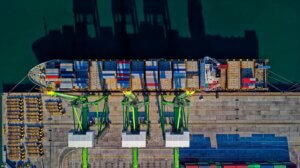Drayage. Definition & types of drayage services
Freight transport, especially international freights transports usually involve numerous steps and transport methods from shipping location to destination. It is common for goods to be transported by road, rail and ship before reaching their endpoint. In this complex process drayage is often a necessary step for completing the transportation process. In this blogpost we will explain the meaning of drayage and describe various types of drayage.

What is drayage?
What is the definition of drayage? Drayage refers to the transportation of goods over a short distance. This can involve transferring goods to their final destination, making it the last step in the logistics process. Typically, this transport can be completed within a single shift. Drayage can also refer to an intermediate step in the logistics chain, such as container drayage. It is a vital component in the logistics and supply chain operations of businesses. Drayage is also known by other terms like haulage or cartage.
The term drayage originates from dray, which is a wagon that was used to be pulled by draught animals. These were used to move goods for short distances, generally at ports for transporting goods to canal and rail terminals.
Container drayage
Container drayage is a term commonly used in intermodal freight transports. When shipping containers arrive at a port, they often need to be moved to a nearby final destination or other transport method, such as rail or canal . This short-distance movement of containers is known as container drayage. It is usually carried out by trucks within metropolitan areas. Drayage services performed by drayage carriers are in high demand in cities with large ports. This growth is partly due to the rise of the e-commerce market, which demands shorter delivery times. Efficient transportation, including drayage, is essential to meet these demands.
Types of drayage services
The Intermodal Association of North America defines 6 types of drayage services.
- Cross-town or inter-carrier drayage: The movement of an intermodal unit “across town” from one railroad to another for the continuation of the shipment, such as sea-to-rail or rail-to-rail transfers.
- Door-to-door drayage: Retail drayage involving over-the-road movement of a unit to a customer location carried out by a drayage truck.
- Expedited drayage: The movement of an intermodal unit over-the-road to ensure timely delivery. This type of drayage usually involves time-sensitive freight, such as food shipments.
- IMX or intra-carrier drayage: The movement of an intermodal unit from a carrier’s rail hub to the same carrier’s intermodal hub. IMX drayage extends the reach of an intermodal hub.
- Pier Drayage: The over-the-road movement of an intermodal unit from a carrier’s rail hub to a port’s dock or pier, where the goods are loaded into a container ship.
- Shuttle drayage: The movement of an intermodal unit either loaded or empty from a hub to another parking lot because the railroad has run out of room at the hub.
Monitor and protect your transports
Are your goods transferred by various transport methods and do you want to secure and monitor your products during transports? Hoefon Security Seals is a certified supplier of security seals, damage indicators and transport monitoring equipment. In our portfolio you will find, among others, container seals, trailer seals, tilt indicators, temperature loggers and humidity loggers. We offer worldwide door-to-door delivery and same day shipping.

Niels Pas
CEO Hoefon Security Seals
Niels Pas has been Hoefon Security Seals’ CEO since 2017. He has extensive international experience and speaks 4 languages professionally.


